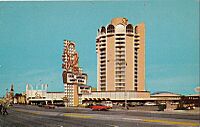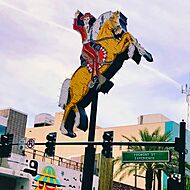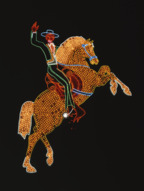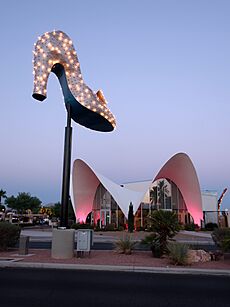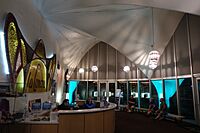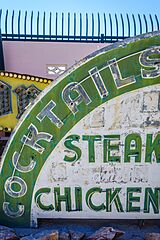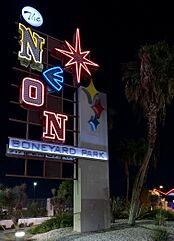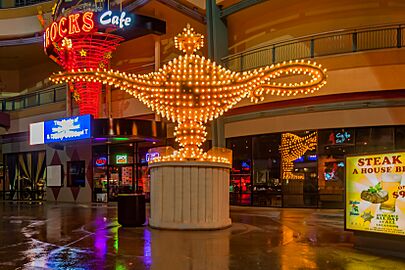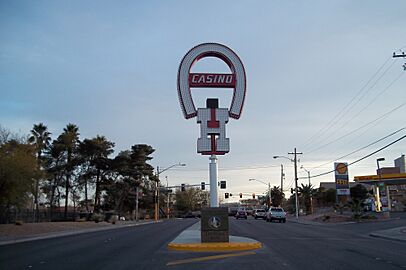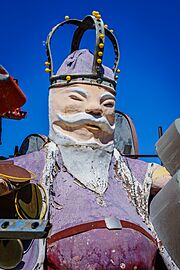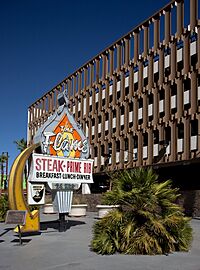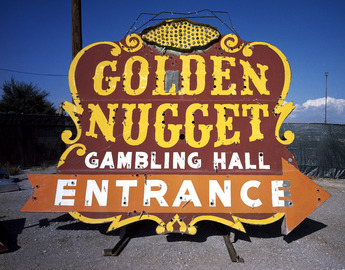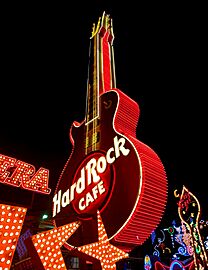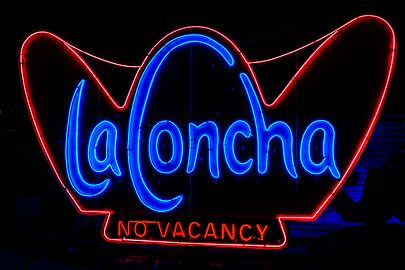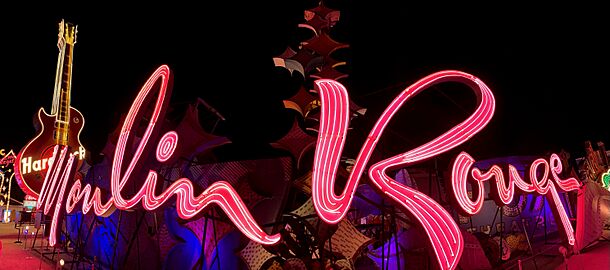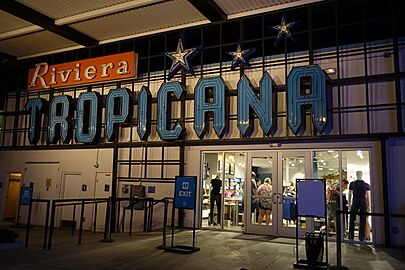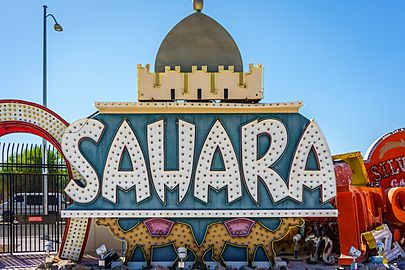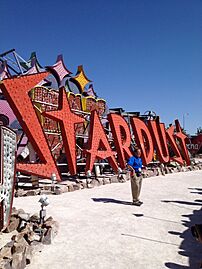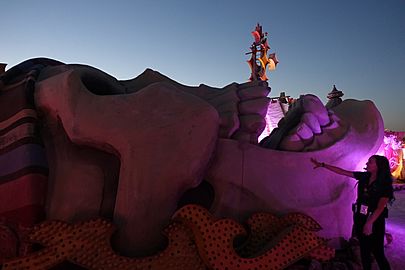Neon Museum facts for kids
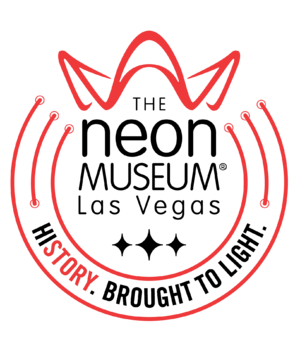 |
|
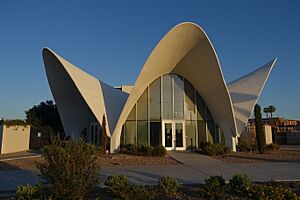
The former La Concha Motel lobby, seen here as the Neon Museum's visitor center in 2017
|
|
| Established | 1996 October 27, 2012 (public opening) |
|---|---|
| Location | 770 North Las Vegas Boulevard, Las Vegas, Nevada |
| Type | Art museum |
| Visitors | 1,800 (2007) 200,000 (2023) |
The Neon Museum in Las Vegas, Nevada, United States, is a special outdoor museum. It shows off old neon signs from casinos and other businesses. These signs are displayed across a large area of about 2.27 acres.
People started trying to create a museum for neon signs in the late 1980s. However, they didn't have enough money or resources at first. On September 18, 1996, the Las Vegas City Council decided to help fund this project. It was then officially named The Neon Museum. The museum began by putting up old signs again in downtown Las Vegas. This helped to bring more visitors to the area.
Young Electric Sign Company (YESCO) made many of the city's neon signs. YESCO also had a place to store old signs. These signs later became part of the Neon Museum's collection. In 2000, YESCO planned to close its storage lot. So, the city gave the museum land to start its own storage area. Tours of this new site, called the Neon Boneyard, began in 2001. At first, you could only visit by making an appointment.
The unique lobby of the old La Concha Motel was given to the museum. It was moved to the museum site in 2006. This lobby eventually became the museum's visitor center. Work to change the lobby started in May 2011. The museum officially opened to everyone on October 27, 2012. This meant visitors no longer needed an appointment.
The Neon Museum has over 200 signs in its collection. The museum site started to get bigger in 2017. However, hundreds of neon items are still stored off-site. This is because there isn't enough space at the main location. In 2024, the museum announced plans to move to two larger places nearby. These new locations are in the 18b The Las Vegas Arts District. The La Concha lobby will also move to one of these new sites. The museum expects to open in its new homes around 2027.
Contents
History of Neon Signs
How the Museum Started
Neon signs first appeared in Las Vegas in the 1920s. They became very popular, especially for hotels and casinos, during the 1930s. Many of these bright signs were made by the Young Electric Sign Company (YESCO). By the 1970s, some people in Las Vegas wanted to save these old neon signs.
The Sands Hotel and Casino on the Las Vegas Strip took down its original neon sign in 1981. This happened during a renovation project. After this, more people started asking for neon signs to be saved. A Sands employee had asked the local Allied Arts Council to save the sign. But the council didn't have the right tools or storage space.
In 1989, the Allied Arts Council and its director, Patrick Gaffey, worked to create a museum. They called it the Neon Park. The 5th Street Liquor Store gave the first neon sign to this project. This sign, added in the late 1940s, was well-known. It showed a hand pouring a bottle into a glass.
Allied Arts chose a spot for the museum along North Las Vegas Boulevard. By 1991, they began storing old signs for the future museum. Some were kept in the Nevada desert. Others were stored at YESCO's Las Vegas building.
By 1994, Allied Arts was having trouble getting money. Another group, the Southern Nevada Cultural Arts Foundation, then announced its own neon museum idea. It was planned for a different location and hoped to open in mid-1995. However, this project also didn't happen. In 1995, Gaffey said his group's problem was not having enough people to really get the project going.
Las Vegas mayor Jan Jones supported the idea of a neon museum. In 1995, she asked city employee Barbara Molasky to help make it happen. Molasky said in 2001 that the idea for a neon museum had been around for 20 or 30 years. But it never came together because of many challenges.
Building the Museum and Early Days
On September 18, 1996, the Las Vegas City Council approved $150,000 to help start the Neon Museum. At first, the project didn't have a physical building. A building was too expensive at that time. Instead, the Neon Museum first focused on putting old neon signs back up. These signs were placed along North Las Vegas Boulevard. This helped bring more visitors to downtown Las Vegas and the new Fremont Street Experience.
The Hacienda resort on the Las Vegas Strip had a famous neon sign. It showed a cowboy on a horse, known as the Horse & Rider sign. This sign was stored for years. The Neon Museum fixed it up for $60,000. It was put back up and lit on November 13, 1996. Its new spot was at North Las Vegas Boulevard and Fremont Street. This was the first big project for the Neon Museum. The city made the museum a nonprofit organization in 1997. Barbara Molasky became its first president. She and the museum's volunteer board got advice from the Museum of Neon Art in Los Angeles.
The city made a deal to get signs from YESCO's storage lot for the new museum. Some signs were very rusty from being outside. Private donations helped pay to fix them. YESCO's storage lot and its signs appeared in movies like Mars Attacks! (1996) and Vegas Vacation (1997). The site later got many requests for tours. YESCO didn't have time to give tours, which is why they supported the Neon Museum.
YESCO eventually planned to close its storage lot. This would give them more room for making new signs. In 2000, the city council gave the Neon Museum a site on North Las Vegas Boulevard. This was near Cashman Field, where the museum could store its neon collection. The site was 0.66 acres. With land next to it, the museum later grew to 2.27 acres. The museum leases this land for just $1 a year.
YESCO continued using its storage lot until 2001. Then, the company started moving signs to the Neon Museum's lot, called the Neon Boneyard. It opened for public visits by appointment later in 2001. By 2002, the site had 75 signs. By 2003, the museum had expanded to the land next door. A second boneyard started there. The collection grew to over 200 signs by 2006. Fifty of these came from YESCO's storage site. The Neon Museum was popular for photo shoots. But most people didn't know about it. It had about 1,800 visitors each year by 2007.
The La Concha Project and Public Opening
The Doumani family owned the La Concha Motel on the Strip. They gave its special shell-shaped lobby to the museum in 2005. The rest of the motel was torn down for new buildings. The museum wanted to use the lobby as its visitor center. Moving and fixing the lobby cost almost $3 million. But this building donation made the museum plans real. It helped them get many public and private grants and donations. In 2006, the lobby was cut into eight pieces. It was moved 3.5 miles north along Las Vegas Boulevard to the museum site.
In 2010, the Neon Museum built a small park. It had desert plants, benches, and signs with information about neon history. This was called the Neon Boneyard Park. It is on the northwest corner of the property. This half-acre project cost $1.9 million. This included paving part of the land for a museum parking lot.
On May 12, 2011, work began to turn the moved La Concha lobby into a visitor center. After it was finished, the Neon Museum officially opened to everyone on October 27, 2012. This ended the old appointment-only system. Before opening, the museum had about 1,000 visitors each month by appointment. The years-long effort to open the museum cost about $6 million. It had 29 employees and 30 volunteers.
Las Vegas mayor Carolyn Goodman hoped the Neon Museum would bring more visitors downtown. The museum had 60,461 visitors in 2013, which was what they expected. About 80 percent of the visitors were from outside Las Vegas. In 2016, the museum's staff needed more office space. They moved from the La Concha building to the old Las Vegas City Hall. The old office space in La Concha became a bigger gift shop for the museum.
Museum Expansion Plans
Hundreds of the museum's neon items are kept in other storage places. This is because there isn't enough room at the main site. In 2017, the city gave the museum a $425,000 grant. This money helped pay for making the main boneyard bigger. This allowed more signs to be put on display. The project needed the museum to buy and tear down the empty L.A. Street Market. This building was right south of the La Concha visitor center.
The Neon Museum only has about 30 percent of its collection on display. So, it wanted to expand even more. In 2019, the city agreed to let the museum use a closed cultural center nearby. This would be for an indoor neon gallery. The parking lot would become a third boneyard for signs. The building needed expensive repairs. But planning and fundraising were delayed because of the COVID-19 pandemic. This led the Neon Museum to pull out of the deal in 2022.
As of 2023, the museum had 200,000 visitors each year. That year, 30,000 people couldn't get in because tours were sold out. In 2024, the museum announced it would move to two larger places nearby. These are in the 18b The Las Vegas Arts District. At least one of the new sites is expected to open by 2027. The original site will stay open until then. This big project is expected to cost $45 million. It will also include moving the La Concha lobby to one of the new locations.
What You Can See at the Museum
The Neon Museum is located at 770 North Las Vegas Boulevard. It covers about 2.27 acres. The museum has the main Neon Boneyard and a smaller North Gallery boneyard. The museum offers tours with guides and tours you can do by yourself. Guides share stories about each sign with visitors.
Many of the museum's signs come from old hotel-casinos in the Las Vegas Valley. These include places like the Stardust, the Riviera, the Flamingo, and the Tropicana. Other signs are from the Moulin Rouge, El Cortez, and New York-New York. You can also see signs from the Plaza, the Debbie Reynolds Hotel, and the Nevada Palace.
Besides hotel and casino signs, the collection also has signs from other local businesses. These include a Hard Rock Cafe, the Peppermill restaurant, and Ugly Duckling Car Sales. The museum also has large fiberglass statues. One is a giant skull from the Treasure Island Hotel and Casino.
Rob McCoy, a former president of the museum, said in 2016 that at first, they had to ask for signs. Now, when a building is closing, the museum is often one of the first places they call. Owners want the museum to have their signs. The Barbara Molasky Acquisition Fund was started in 2021. This fund helps the museum buy signs that owners are not donating.
As of 2023, the museum displays about 250 signs. Some date back to the 1930s. The oldest piece is a part of a sign from the Green Shack restaurant. The museum also has newer signs. Private donors help pay to fix up the signs. Restoring a sign can cost from $10,000 to $100,000. It can take three to six months. Because of the cost, many signs in the boneyard are not fixed up. They don't light up on their own during night tours. Instead, they are lit by outside lights. Some signs are very important to fix. This is usually because they are historic or getting damaged quickly.
As of 2023, the museum hosted 200 weddings each year.
Scenic Byway Project
In 2009, a part of Las Vegas Boulevard was named a National Scenic Byway. To go along with this, the museum added several old neon signs along the street. This included one from the downtown casino Binion's Horseshoe. A neon slipper, from the torn-down Silver Slipper casino, was added to the median in front of the museum. These new signs joined others already on Las Vegas Boulevard, like the Hacienda's Horse & Rider.
Shows and Art at the Museum
In 2018, the museum started a 30-minute show called Brilliant! by artist Craig Winslow. It uses projection mapping to make the unlit signs in the North Gallery look like they are working again. The show plays with old and new music. The show was updated in 2021. That year, artists Nanda Sharif-pour and Ali Fathollahi created a mural for the museum. It is called Las Vegas Luminaries. It is in the North Gallery, at the entrance to Brilliant!. The mural shows 11 people important to the city's art history. These include entertainers Liberace and Sammy Davis Jr., and sign designer Betty Willis.
Lost Vegas: Tim Burton, an art show by film director Tim Burton, was at the Neon Museum. It ran from October 2019 to February 2020. It showed over 40 art pieces by Burton.
Gallery
The following images are from the museum's two boneyards, unless stated otherwise.
-
Moulin Rouge sign
-
1990s sign from the Sahara resort
See also
 In Spanish: Neon Museum para niños
In Spanish: Neon Museum para niños


